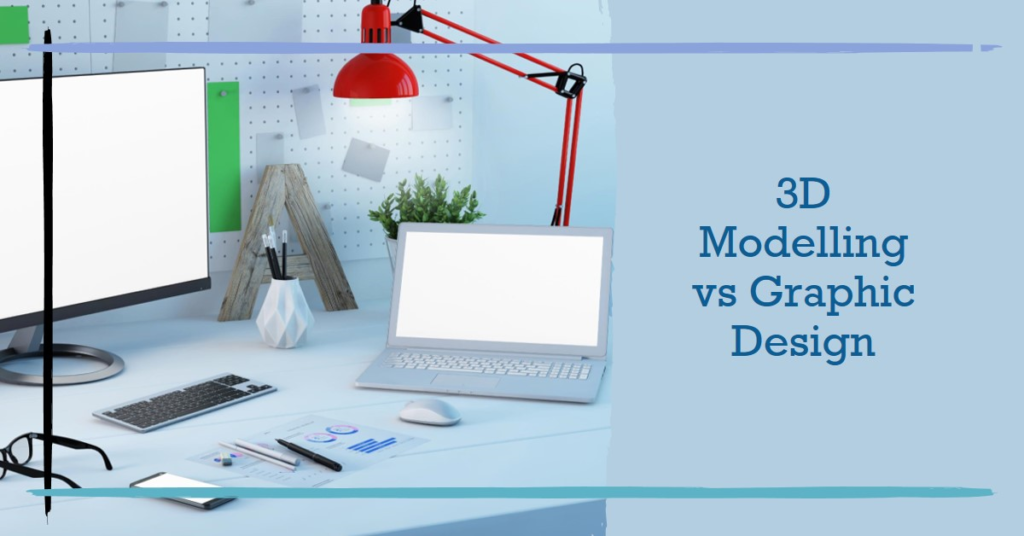
Table of Contents
- Introduction:
- Understanding 3D Modeling:
- Grasping Graphic Design:
- Skill Sets and Tools:
- Career Opportunities:
- Creative Process:
- Output and Applications:
- Learning Curve:
- Industry Trends:
- Making the Choice:
- Conclusion:
Introduction:
In the dynamic world of visual content creation, professionals and enthusiasts alike often face the pivotal decision: Should they delve into 3D modeling or stick with traditional graphic design? This choice is not merely about selecting a tool or technique; it’s about shaping one’s creative journey and professional path. This blog post explores the nuanced differences between 3D modeling and graphic design, providing insights to help you make an informed decision.
Understanding 3D Modeling:
3D modeling involves creating three-dimensional representations of objects using specialized software. These models can range from simple geometric shapes to highly detailed and textured figures used in films, games, and simulations.
In 3D modeling, artists work in a virtual space where they can manipulate objects by adjusting vertices, edges, and faces. This process requires a good understanding of spatial relationships and geometry. The end result is a versatile model that can be rendered, animated, and integrated into various applications, making 3D modeling a cornerstone in fields such as animation, gaming, and virtual reality.
Grasping Graphic Design:
Graphic design, on the other hand, focuses on creating visual content to communicate messages. This discipline involves the use of typography, imagery, color, and layout to produce everything from logos and brochures to websites and advertisements.
Graphic designers employ tools like Adobe Photoshop, Illustrator, and InDesign to bring their ideas to life. Their work is typically two-dimensional, meant to be viewed on screens or printed media. Effective graphic design hinges on a keen sense of aesthetics, an understanding of user experience, and the ability to convey messages clearly and compellingly.
Skill Sets and Tools:
The skill sets required for 3D modeling and graphic design overlap in some areas but differ significantly in others. Both disciplines demand a strong artistic foundation, but each has unique technical requirements.
3D modelers must master software such as Blender, Maya, and ZBrush. These tools allow them to create complex models and animations. Additionally, understanding lighting, texturing, and rendering techniques is crucial. On the flip side, graphic designers need proficiency in Adobe Creative Suite and a solid grasp of design principles like balance, contrast, and hierarchy.
Career Opportunities:
Career opportunities in both fields are abundant, but they cater to different industries and job roles. 3D modeling opens doors to careers in animation studios, game development companies, and virtual reality firms. Positions like 3D animator, game artist, and VFX artist are common in this realm.
Graphic design careers are prevalent in advertising agencies, corporate marketing departments, and design studios. Common roles include graphic designer, art director, and brand strategist. Each career path offers unique challenges and rewards, shaping the professional landscape for creative individuals.
Creative Process:
The creative processes in 3D modeling and graphic design, while sharing some similarities, diverge in their execution and outcomes. Both begin with conceptualization, where ideas are brainstormed and initial sketches are created.
In 3D modeling, the process involves constructing a digital skeleton, adding details, and refining the model through multiple iterations. This workflow requires a high level of technical proficiency and patience. Graphic design, meanwhile, emphasizes the arrangement of visual elements within a confined space, focusing on the composition, color schemes, and typographic choices to deliver a clear message.
Output and Applications:
The outputs of 3D modeling and graphic design serve different purposes and audiences. 3D models are used in animated films, video games, and virtual simulations, providing immersive experiences. These models can be animated to create lifelike characters and environments, enriching storytelling in digital media.
Graphic design outputs, such as logos, posters, and websites, aim to communicate brand identities and marketing messages. These designs are essential for building brand recognition and engaging audiences across various platforms. The immediate visual impact and clarity of graphic design make it indispensable in marketing and advertising.


Learning Curve:
The learning curves for 3D modeling and graphic design are steep but distinct. Mastering 3D modeling involves understanding complex software and the principles of three-dimensional space. Beginners often face challenges in learning the technical aspects of modeling, texturing, and rendering.
Graphic design, while also challenging, focuses more on mastering design principles and software tools. Aspiring graphic designers need to develop a strong sense of aesthetics and the ability to create visually appealing compositions. Both fields require dedication and continuous learning to stay updated with evolving trends and technologies.
Industry Trends:
Industry trends in 3D modeling and graphic design are continually evolving, influenced by technological advancements and changing consumer preferences. In 3D modeling, trends like real-time rendering, augmented reality (AR), and virtual reality (VR) are gaining traction. These technologies enhance user experiences, making 3D models more interactive and lifelike.
Graphic design trends, meanwhile, focus on minimalism, bold typography, and the integration of motion graphics. The rise of social media and digital marketing has also driven the demand for dynamic and responsive designs that adapt to various screen sizes and platforms. Staying abreast of these trends is crucial for professionals in both fields.
Making the Choice:
Deciding between 3D modeling and graphic design ultimately depends on your interests, skills, and career aspirations. If you are fascinated by creating lifelike characters and immersive environments, 3D modeling might be your calling. This field offers the thrill of bringing virtual worlds to life and the satisfaction of seeing your creations in action.
On the other hand, if you have a passion for visual storytelling and branding, graphic design could be the perfect fit. This discipline allows you to communicate powerful messages through striking visuals, playing a vital role in shaping public perception and brand identity. Both fields offer rewarding careers, but the right choice depends on where your creative inclinations lie.
Conclusion:
In conclusion, both 3D modeling and graphic design are vital components of the visual content creation landscape. Each discipline has its unique set of skills, tools, and applications, catering to different creative aspirations and career paths. By understanding the nuances of each field, you can make an informed decision that aligns with your interests and professional goals. Whether you choose the technical intricacies of 3D modeling or the artistic finesse of graphic design, you’ll be contributing to the ever-evolving world of visual communication.



